Murat, that sport in the bow is not helping at all.. Is this the Moose River that drains into Hudson's Bay?
-
Happy National Pfeffernusse Day! ⚪🇩🇪😋
You are using an out of date browser. It may not display this or other websites correctly.
You should upgrade or use an alternative browser.
You should upgrade or use an alternative browser.
Canoe Art: Paintings, Sketches, Sculpture, Architecture
- Thread starter Murat V
- Start date
Murat, that sport in the bow is not helping at all.. Is this the Moose River that drains into Hudson's Bay?
Lazy sport with all that fishing! Guess that's what they would've paid the big bucks for back then. It's gotta be the Moose river closer to home. The image was part of a larger collage featuring scenes of camp life in Maine originally published in Harper's Weekly (Aug 1888)...

Found a seller of the same print on Ebay that has much larger pics if you're interested in a closeup (HERE). My longterm project is to try and do a woodburning version of this on a 5'x7' birch panel for our cottage wall
http://blog.steersman.ca/wp-content/uploads/2010/09/TomThomson_CanoeandLakeAlg_FS.jpg

That's as big as I can make it, but the link will take you to it.
Tom Thomson, Canoe and Lake, Algonquin
I like that it is mostly about the sky, as in most of his work.

That's as big as I can make it, but the link will take you to it.
Tom Thomson, Canoe and Lake, Algonquin
I like that it is mostly about the sky, as in most of his work.
Last edited:
One of my favourite Thomson paintings, Sturgeon.
He did another one simply entitled "The Canoe". It's been recreated as a mural in Huntsville, Ontario close to their public library. Here's a pic I took a while back



If anyone is interested, Huntsville has 33 murals recreating the works of the Group of Seven all over their downtown area. Pretty neat to walk around and see this outdoor themed gallery...
http://www.thegroupofsevenoutdoorgallery.com/Huntsville.aspx.
Obama and the other G8 leaders did some painting here back during the summit in 2010.
He did another one simply entitled "The Canoe". It's been recreated as a mural in Huntsville, Ontario close to their public library. Here's a pic I took a while back



If anyone is interested, Huntsville has 33 murals recreating the works of the Group of Seven all over their downtown area. Pretty neat to walk around and see this outdoor themed gallery...
http://www.thegroupofsevenoutdoorgallery.com/Huntsville.aspx.
Obama and the other G8 leaders did some painting here back during the summit in 2010.
G
Guest
Guest
Thanks for these art blogs Murat; what a great thread! I'm in Huntsville occasionally, and will look out for those murals. I bought a framed print of "The Canoe" for our son, and stood for a long time lost in that painting.
Hope it's OK to keep this thread going...
Here's another local artist I've met (online) who features some canoe related art.
Katie Ohlke of Stone Ridge Art Studio
She does some artistic carvings of paddles and paintings inspired by historic photos. Here's her version of a famous photo of Tom Thomson in his personal canoe (assumed to be a Chestnut Cruiser dating from before the 1921 Chestnut Factory fire)
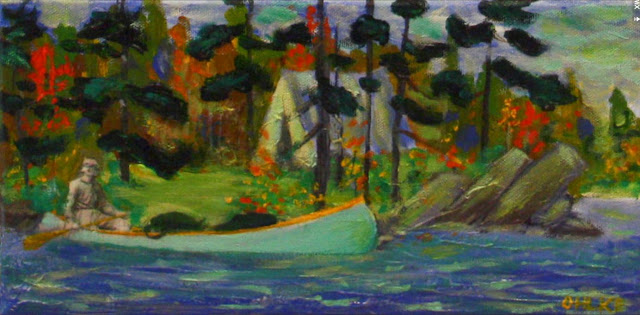
Day Trip from Artists Camp
The original photo...
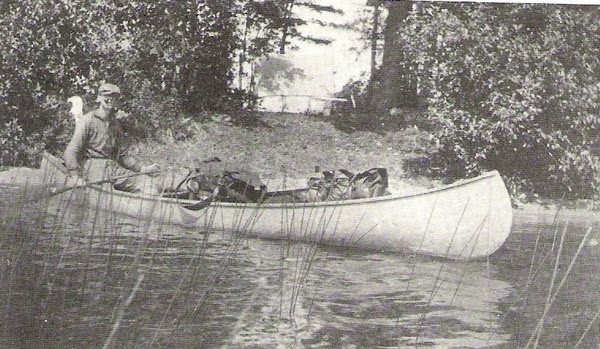
Here's another local artist I've met (online) who features some canoe related art.
Katie Ohlke of Stone Ridge Art Studio
She does some artistic carvings of paddles and paintings inspired by historic photos. Here's her version of a famous photo of Tom Thomson in his personal canoe (assumed to be a Chestnut Cruiser dating from before the 1921 Chestnut Factory fire)
Day Trip from Artists Camp
The original photo...

G
Guest
Guest
Murat,
I like the thread and look at it every chance.
Roy's "Follow what i say....." got comment.
The breaks in the tree trunks look like pictorial necessity: the age old challenge of very strong verticals too obstrusively thrusting up out of the frame unopposed; the image doesn't work so well if the trunks are solid. Besides feeling how the breaks weight down the thrust, notice how well they also create a nice diagonal movement along with the paddle blade, the paddler's thigh, etc. That sweep has it's own grace and is the main opposition and balance to the strong diagonals of the canoe and its shadow. There's a nice flourish of lines here.
The breaks, so strong, were a risk. I might have softened them some, but maybe because I'm exposed to non-traditional imagery more than most, I accepted them along with all the rest of the artist's abundant and powerful distortions. They didn't themselves make me wonder about their "meaning", if in fact there was one intended at all.
Possibly there are some specific cultural, social, political allusions there, but I don't know what they are. That's not necessary for me to like the piece anyway. I just look at it, and I like the way it looks, and how it creates a whole convincing world which I can get into for a little while, where my imagination wanders around. Maybe someday I'll realize that this experience means something. Maybe not. After all this time we still don't know what Mona Lisa's smile means, but most of us still like the painting.
Yeah, I do have to say that breaks in the trunks are pretty bold. They actually do risk drawing too much attention. Just maybe the title is a little humorous self consciousness on Roy's part.
I like the thread and look at it every chance.
Roy's "Follow what i say....." got comment.
The breaks in the tree trunks look like pictorial necessity: the age old challenge of very strong verticals too obstrusively thrusting up out of the frame unopposed; the image doesn't work so well if the trunks are solid. Besides feeling how the breaks weight down the thrust, notice how well they also create a nice diagonal movement along with the paddle blade, the paddler's thigh, etc. That sweep has it's own grace and is the main opposition and balance to the strong diagonals of the canoe and its shadow. There's a nice flourish of lines here.
The breaks, so strong, were a risk. I might have softened them some, but maybe because I'm exposed to non-traditional imagery more than most, I accepted them along with all the rest of the artist's abundant and powerful distortions. They didn't themselves make me wonder about their "meaning", if in fact there was one intended at all.
Possibly there are some specific cultural, social, political allusions there, but I don't know what they are. That's not necessary for me to like the piece anyway. I just look at it, and I like the way it looks, and how it creates a whole convincing world which I can get into for a little while, where my imagination wanders around. Maybe someday I'll realize that this experience means something. Maybe not. After all this time we still don't know what Mona Lisa's smile means, but most of us still like the painting.
Yeah, I do have to say that breaks in the trunks are pretty bold. They actually do risk drawing too much attention. Just maybe the title is a little humorous self consciousness on Roy's part.
Last edited:
G
Guest
Guest
His bio talks about tripping in the Temagami region. There's been renewed pressure to re-activate logging & mining activities in some of the protected old growth reserves along well known paddling routes. Maybe a subtle message about how we're right at the proverbial "tipping" point with the loss of those trees. But of course, he's from Toronto and according to the John Stewart Daily Show - everyone here in Toronto is on crack. Guess you never can really know what's happening in the mind of an artist.
Anyway, back to more traditional illustrators. Acer mentioned F.E. Schoonover... I finally was able to find the source of this classic image...
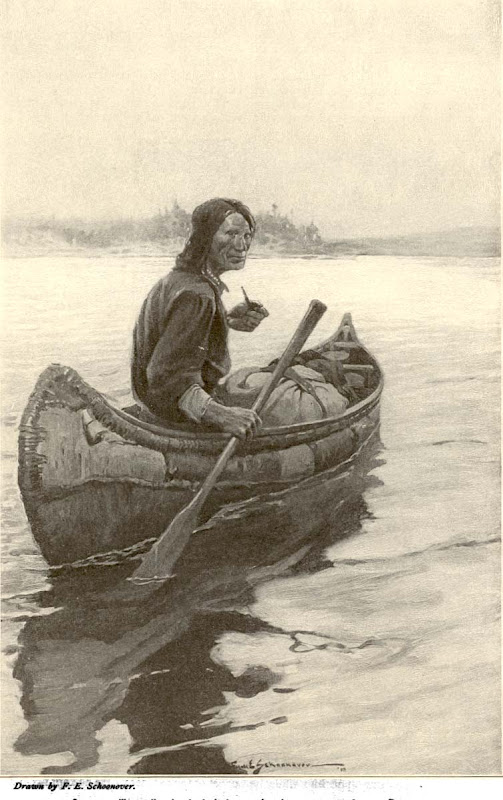
It's from a Scribner's Magazine short fiction article entitled, "His Quest, and the End of It" by Gerald Chittenden (VOL XLVIII, July, 1910)
"Quest" is hard to resist. The design and the tonal drama pull me in from across the room, and the drawing and details keep me looking for a long time.
Such long close looking makes it easy to decide eventually that the picture is a product of the artist's time and place as much as it is of his individuality. The title is late 1800s/ early 1900s hyperbole, and the sentiment of the image itself is more than frank. It is admiring and suggests that the viewer is sharing a moment of mutual recognition with the paddler.
The view of the Indian as the authentic outdoorsman was pretty normal to urban "sports" in the eastern US, which was the big market for illustrators. There was a huge boom in outdoor recreation going on in the region.
Out in Wisconsin and Minnesota, where there actually were lots of Indians, the general attitude was not respectful. And the federal government had just banned most public ceremonies associated with traditional native faiths.
I think that the horizontal seam across the stern of the canoe is artistic license. It jumped out at me right away. I remember seeing something like it only on the big fur trade canoes. But my copy of BARK CANOES AND SKIN BOATS OF NORTH AMERICA is out on loan, so I can't check now.
"Hope it's OK to keep this thread going..."
Please do, I am enjoying and learning from it. Nice reply acer to the Quest drawing. I have nothing to add to it, don't know why I like it so much, but it does keep my attention, and admiration for the artist and the subject.
Please do, I am enjoying and learning from it. Nice reply acer to the Quest drawing. I have nothing to add to it, don't know why I like it so much, but it does keep my attention, and admiration for the artist and the subject.
I think that the horizontal seam across the stern of the canoe is artistic license. It jumped out at me right away. I remember seeing something like it only on the big fur trade canoes. But my copy of BARK CANOES AND SKIN BOATS OF NORTH AMERICA is out on loan, so I can't check now.

I think the seam is okay. Here is an 1890s canoe, courtesy of the Minnesota Historical Society.
By the way, Acer, I have to say I like your attention to context. Every remark, observation, opinion, comment...all of them are carefully tied down to their place and time. I see that attention in your observations on life in your region, your river, etc. Carry on!
Last edited:
Don't want to hijack the thread, but...I got looking for birch bark canoes, and ended up at one of my favourite films. It qualifies as canoe art, and is an hour well spent, in my opinion.
I tried to embed it, but failed, (hence the deleted post above), but here is a link to Cesar's Bark Canoe.
http://www.nfb.ca/film/cesars_bark_canoe#temp-share-panel
I tried to embed it, but failed, (hence the deleted post above), but here is a link to Cesar's Bark Canoe.
http://www.nfb.ca/film/cesars_bark_canoe#temp-share-panel
G
Guest
Guest
Thanks for the NFB link Sturgeon. This study and appreciation of birch bark canoes is wonderful stuff. I'm not sure, but I think there's one here :
https://www.canoemuseum.ca/home
I haven't visited this museum, but I'll get there someday soon.
I love that Schoonover painting of the FN paddler looking back over his shoulder, with pipe in hand. The perspective pulls me along with the paddler, and onwards towards the horizon; curious to see beyond the distant trees.
https://www.canoemuseum.ca/home
I haven't visited this museum, but I'll get there someday soon.
I love that Schoonover painting of the FN paddler looking back over his shoulder, with pipe in hand. The perspective pulls me along with the paddler, and onwards towards the horizon; curious to see beyond the distant trees.
There is not just one birchbark at the Canadian Canoe Museum. There must be forty back in the archives. When the WCHA Assembly was there we got to take a tour of that building. I remember Ferdy Goode spending three hours under those canoes. Ferdy is a birch bark maker..fine craft. Steve Cayard is another. Both make art.
http://www.wcha.org/bbresource.php
I was able once to paddle Steve Cayards canoe on his home page.
http://www.wcha.org/bbresource.php
I was able once to paddle Steve Cayards canoe on his home page.
Acer, thanks for your many insights on these artworks. I've stared at these pics for extended periods trying to get into the mind of the artist and would've never come up with some of your attentive observations.
I've seen the long horizontal seam on some historic photos of shorter length bark canoes. Guess by that time, suitable birch bark was getting harder to find, so the full length seam became a necessity. Here's a pic from the Keewaydin photo archive featuring another short bark canoe being snubbed down some rapids. There's a discernible full length horizontal seam too.
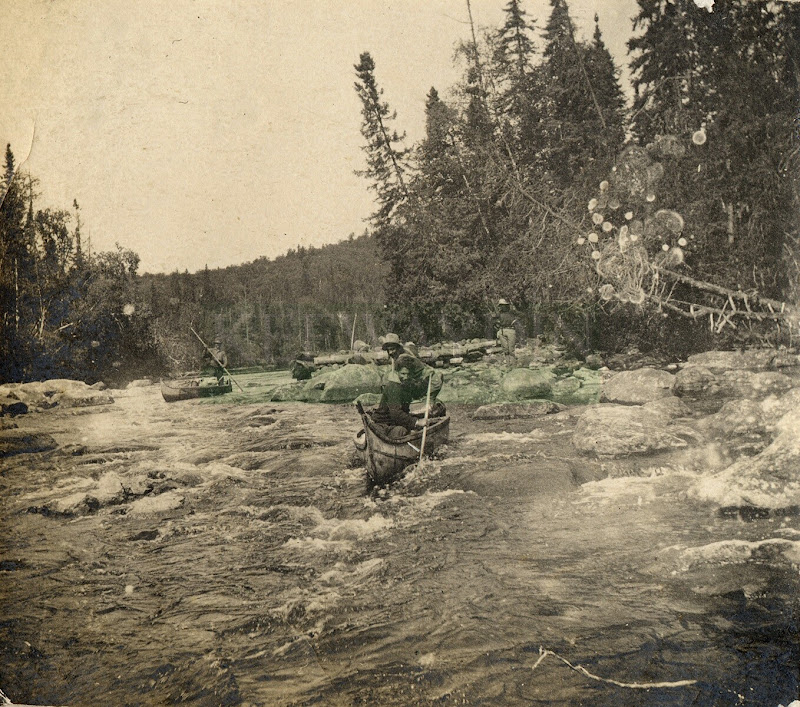
I've seen the long horizontal seam on some historic photos of shorter length bark canoes. Guess by that time, suitable birch bark was getting harder to find, so the full length seam became a necessity. Here's a pic from the Keewaydin photo archive featuring another short bark canoe being snubbed down some rapids. There's a discernible full length horizontal seam too.

Not a hijack at all, Sturgeon. That's one of my favourite canoe films...virtually silent but so engaging! Before it was online for free, I would routinely go down to the National Film Board viewing station in downtown Toronto (John & Adelaide) where for a $2 donation you could watch nearly all the videos in their collection. They've since closed the place down. Must have spent a good 10 hours watching this film over and over again to study the construction process for my own bark canoe build. Also like the part where he "loses" his crooked knife under all the cedar sheathing and has to dig it out again...like a surgeon forgetting a scalpel in a patient.
By the way, if you haven't seen it, there's a new video posted on Vimeo recently featuring a 2002 bark canoe build on the Penobscot Nation. It has more dialogue explaining the steps. The film-maker has disabled embedding on other sites but here's the direct link...
http://vimeo.com/77745115
Steve Cayard was the builder. What a lucky treat to paddle one of his floating masterpieces YC!
By the way, if you haven't seen it, there's a new video posted on Vimeo recently featuring a 2002 bark canoe build on the Penobscot Nation. It has more dialogue explaining the steps. The film-maker has disabled embedding on other sites but here's the direct link...
http://vimeo.com/77745115
Steve Cayard was the builder. What a lucky treat to paddle one of his floating masterpieces YC!
G
Guest
Guest
I'm not sure, but that NFB film you posted Sturgeon (thanks for that BTW) might have been one I saw years ago, when my wife and I used to get together with other food co-op members to place orders, catch up on news/gossip, and socialize. It's a lovely film.
Those masterpieces in birch bark are exquisite, thanks for that link YC.
Who would've thought those bark canoes were rugged enough to snub down bony rivers Murat! I know they're light, but perhaps they're not so fragile as I thought.
Those masterpieces in birch bark are exquisite, thanks for that link YC.
Who would've thought those bark canoes were rugged enough to snub down bony rivers Murat! I know they're light, but perhaps they're not so fragile as I thought.
Back in 2010, I had contacted artist John Buxton for permission to repost some of his historical art on my site and he graciously accepted. Much of his work features birchbark canoes and other scenes of colonial times. Here's one with amazing detailed called "Dry Mocassins". Had some fun looking over all that heritage gear...

The non-decorated paddle in the foreground has a flat, stubby, grip design I was researching at the time. Turns out there are nearly identical paddles in the collection of the Royal Ontario Museum labelled as Iroquois paddles...
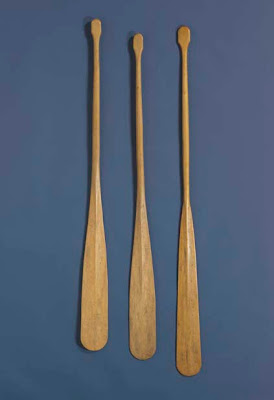
ROM Paddles - Iroquois
late 19th - early 20th century
Area of Origin: Northeast; Ontario; Canada; North America; Six Nations of the Grand
922.1.12

The non-decorated paddle in the foreground has a flat, stubby, grip design I was researching at the time. Turns out there are nearly identical paddles in the collection of the Royal Ontario Museum labelled as Iroquois paddles...

ROM Paddles - Iroquois
late 19th - early 20th century
Area of Origin: Northeast; Ontario; Canada; North America; Six Nations of the Grand
922.1.12
G
Guest
Guest
Superb post Murat. On J.Buxton's website, he discusses the bark canoe here : http://www.buxtonart.com/agilebarkcanoe.html
Thanks Murat.
Thanks Murat.
Thanks Murat. I love those types of images.
That reminds me of a time when I had to study Frances Anne Hopkins's paintings to gather props from the collection at Fort William Historical Park, in order to help the NFB make a film about her. This was in the mid-nineties.
Just now, I wanted to link an image to illustrate this anecdote, so I found a great website where someone had posted detailed close-ups of sections of her works. Guess whose website I found?
Guess whose website I found?
Yours, of course! [Murat V's!]
http://paddlemaking.blogspot.ca/2009/07/frances-anne-hopkins-paddles.html
Haha! You were studying the paddles. I had to make sure the blankets, cassettes, kettles, etc., matched the paintings.
[i was particularly proud of a white leather-covered cassette that Mr. Hopkins carries onto the beach that matches the one at the bow of the canoe in the painting of the voyageurs passing a waterfall.
That reminds me of a time when I had to study Frances Anne Hopkins's paintings to gather props from the collection at Fort William Historical Park, in order to help the NFB make a film about her. This was in the mid-nineties.
Just now, I wanted to link an image to illustrate this anecdote, so I found a great website where someone had posted detailed close-ups of sections of her works.
Yours, of course! [Murat V's!]
http://paddlemaking.blogspot.ca/2009/07/frances-anne-hopkins-paddles.html
Haha! You were studying the paddles. I had to make sure the blankets, cassettes, kettles, etc., matched the paintings.
[i was particularly proud of a white leather-covered cassette that Mr. Hopkins carries onto the beach that matches the one at the bow of the canoe in the painting of the voyageurs passing a waterfall.
The film
http://www.nfb.ca/film/petticoat_expeditions_part_two
I got a credit for props, haha. Filmed mostly at Silver Islet at the end of the Sibley Peninsula near Thunder Bay, and on Lake Marie-Louise, in Sleeping Giant park a few km north of Silver Islet.
You can see there were some problems with canoe trim, which luckily they worked out before hitting the big lake swells.
http://www.nfb.ca/film/petticoat_expeditions_part_two
I got a credit for props, haha. Filmed mostly at Silver Islet at the end of the Sibley Peninsula near Thunder Bay, and on Lake Marie-Louise, in Sleeping Giant park a few km north of Silver Islet.
You can see there were some problems with canoe trim, which luckily they worked out before hitting the big lake swells.
Similar threads
- Replies
- 4
- Views
- 2K
